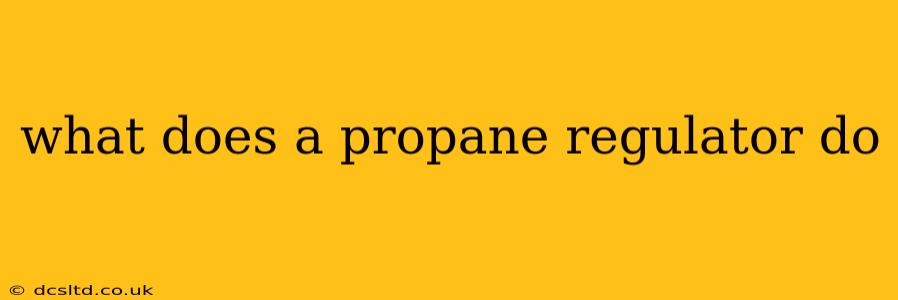Propane, a versatile and widely used fuel source, requires careful management to ensure both safety and efficient operation. A crucial component in this process is the propane regulator. But what exactly does a propane regulator do? This comprehensive guide delves into the function, types, and importance of propane regulators, answering common questions many homeowners and propane users have.
What is the Function of a Propane Regulator?
The primary function of a propane regulator is to reduce the high pressure of propane gas stored in a tank to a lower, usable pressure for appliances. Propane tanks store the gas under significantly high pressure – typically around 200-250 PSI (pounds per square inch). This pressure is far too high for safe and efficient use in household appliances like grills, stoves, or furnaces. A regulator acts as a pressure-reducing valve, safely lowering the pressure to a much safer and appropriate level, usually around 11 inches of water column (WC) for residential appliances. This controlled, lower pressure prevents dangerous surges of gas and ensures consistent fuel delivery.
How Does a Propane Regulator Work?
Propane regulators employ a sophisticated system of valves and diaphragms. The high-pressure gas from the tank enters the regulator. A diaphragm, a flexible membrane, is pushed by the incoming high-pressure gas. This movement activates a valve mechanism that controls the gas flow to the appliance, releasing only the necessary lower-pressure gas. The regulator maintains this lower pressure consistently, even as the gas flow fluctuates based on appliance demand.
What are the Different Types of Propane Regulators?
Several types of propane regulators cater to various applications:
- Single-Stage Regulators: These are the most common type found in residential settings. They reduce the high tank pressure to a lower pressure in a single stage.
- Two-Stage Regulators: These regulators employ two stages of pressure reduction, offering finer control and greater precision. They are often used in larger-scale applications or where highly consistent low pressure is critical.
- Overpressure Protection: All propane regulators should have overpressure protection built-in as a crucial safety feature. This feature prevents excessive pressure from reaching the appliance, preventing potential hazards.
What Happens if a Propane Regulator Fails?
A malfunctioning propane regulator can lead to several potentially dangerous situations:
- Excessive Gas Flow: A faulty regulator might fail to adequately reduce pressure, resulting in a dangerously high gas flow to appliances. This can cause appliances to malfunction, or even potentially lead to a gas leak or explosion.
- Insufficient Gas Flow: Conversely, a malfunctioning regulator might not provide enough gas to the appliance, leading to poor performance or the appliance failing to operate altogether.
- Gas Leaks: A damaged or worn-out regulator can lead to gas leaks, creating a significant fire hazard.
How Often Should I Check My Propane Regulator?
Regular inspection of your propane regulator is crucial for safety. While there isn't a universally prescribed timeframe, visual checks for damage, corrosion, or leaks should be conducted at least annually, and ideally before each propane season. If you notice any damage or suspect a leak, immediately contact a qualified propane professional.
How Can I Tell if My Propane Regulator is Bad?
Signs of a failing propane regulator can include:
- Visible Damage: Look for cracks, dents, or corrosion on the regulator.
- Unusual Noises: Hissing or whistling sounds emanating from the regulator are warning signs of a potential leak or malfunction.
- Low Gas Pressure: If your propane appliances are underperforming despite having a full tank, it could indicate a problem with the regulator.
- Strong Smell of Propane: A strong propane smell near the regulator indicates a leak and requires immediate attention.
What Should I Do if I Suspect My Propane Regulator is Faulty?
If you suspect your propane regulator is malfunctioning, immediately turn off the gas supply at the tank valve. Do not attempt to repair the regulator yourself. Contact a qualified propane technician or service professional to inspect and replace the regulator if necessary. Remember, safety is paramount when dealing with propane gas.
This comprehensive guide should provide a clear understanding of the function and importance of a propane regulator. Regular inspection and proper maintenance are crucial for safe and efficient propane use. Remember, always prioritize safety and contact a qualified professional for any concerns related to propane equipment.
